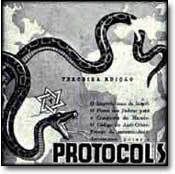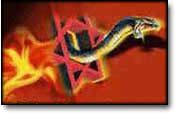Your daily dose -as prescribed by your Jewish doctor. Gee why we get these stories every other minute? Every other hour? Every other week? Every other year? Every other decade? ... Never mind let's forget about the 40 Million Euro/Russians murdered by Jew Hitler and weep for the lying survivors!
When she was just eight years old, Madeleine Testyler was taken - together with over 13,000 of Paris' Jews - to city's winter stadium to be transferred to concentration camps. Now, with release of new film 'La Rafle', she speaks of her survival
July 16, 1942 is a day Madeleine Testyler, like all Jews living in occupied Paris at the time, will never forget. On that day, 13,152 Jews, mostly women and children, were rounded up and taken to Vélodrome d'Hiver, the indoor cycling track next to the Eifel Tower. Within days they were sent from there to the Drancy, Pithiviers, Compiègne and Beaune-la-Rolande transit camps, from which they were transported to Auschwitz. Less then 40 of them got out alive.
This event, which was recently retold in the French film "La Rafle (The Round Up)", and code-named "Operation Spring Breeze" by the Nazis, was actually not carried out by the Germans, but by the French. While the order to gather all the city's helpless Jews was given by the SS headquarters in Paris, the execution itself was led by hundreds of French police officers and gendarmes, who operated according to lists of addresses given by the municipality.
Madeleine Testyler, then Madeleine Reiman, is one of the few Jews to have survived what has since been dubbed "the roundup". She was only eight years old when she was taken to the Vel' d'Hiv stadium with her mother and six-year-old sister Arlette.
Before leaving their apartment, the mother managed to phone the owners of one of France's leading fur companies, and told them about the arrest. Madeleine's father, Abraham Reiman, who worked for the company along with his wife, was sent to camps along with some 4,000 other men a year earlier. At the time, the mother begged the company's owner to help secure her husband's release before he was transferred from Pithiviers, but to no avail.
"You didn't help my husband," she told him over the phone, "at least try to help us." This telephone call would later save her and her daughters' lives.
Corridor to Auschwitz
France's Jewish citizens at that time were still protected, or so they thought. Sarah Schwarz, today an 83-year-old pensioner from Herzliya, was 14 on the day that would become an eternal trauma for any Jew living in France during that period. Being a French citizen, she explains, she was protected. "We lived in a house near a large garage," she says, the anguish still showing on her face 68 years later. "The gendarmes parked a bus at the entrance to the garage and crammed into it dozens of Jews from our street, our neighbors and friends. It was a horrifying sight." Days later the family left Paris and found refuge in the south of France, which was not under occupation.
Madeleine and her family did not hold French citizenship. Along with many other Jews, they were loaded onto three trucks and taken to the stadium. "Being among the first, we found a corner for ourselves between two stands," 76-year-old Madeleine says from her home in Tel Aviv. "To my little sister and I the whole thing just seemed like a game at the time."
After days in crowded and very basic conditions, the Jews were taken to camps that, as it later became apparent, served as nothing more than a corridor to Auschwitz. Up until that moment the mother hoped they would be sent to Pithiviers.
"When father was at Pithiviers a year earlier, mother tried to visit him and take him a parcel with food and clothes, but the guards didn't let her do that," Madeleine says. "On the train back to Paris, a woman approached her and asked her why she was crying. When mother told her her husband was in the camp, the woman promised her she would try to help, since her husband was one of the camp's head guards."
The woman's husband, Gaston Schiffmacher, a police officer originally from Lorraine, did indeed serve as an officer at Pithiviers. With Alsace-Lorraine's annexation to Germany in 1940, he was forced to join Hitler's army and became a guard at the concentration camp, despite the fact that he, just as most residents of Alsace-Lorraine, loathed the Germans. After the encounter on the train, Schiffmacher and his wife invited to girls Madeleine and Arlette to stay with them. The mother couldn't have asked for a better safe house for her two daughters. But in the summer holiday of 1942, the two returned to their mother's house in Paris and were taken with her during the roundup. The three were eventually taken to the Beaune-la-Rolande camp.
"While mother was appointed head of the living quarters," Madeleine says, "this did not really improve our situation." The girls shared a bunk with eight-year-old Lazar Sheinbuch and his four-year-old sister Rezin, their neighbors from Paris.
But fate was kind to the mother and her daughters. The owner of the fur company she had phoned on the day of their arrest had pulled a few strings, and the three were released not long after they reached the camp. "We even got a permit to be in the street after curfew hours for the Jews in Paris, because our train was going to arrive in the city in the evening hours."
The Sheinbuch children, on the other hand, were not so lucky. "That entire family was exterminated," Madeleine says with grief that seems to be very much alive to this day. "We slept with them on the same bunk," she says, adding that when they left the camp, her mother offered to take the neighbor's children, but their mother refused to part with them. "She said she heard that all the children would be released soon."
Shortly after their release the mother and her daughters left Paris, again with the help of the fur company owners, and moved to Vendome, which was not under occupation, and hid out until the end of the war.
Of the 42,000 Jews sent to Auschwitz in 1942, only 811 survived – it was the highest rate of murders of all transfers from around Europe that year. Madeleine's father, Abraham Reiman, never returned.
"Mother refused to believe that father wasn't coming home," Madeleine recounts, "For months, she would go every day to the Lutetia Hotel, where the headquarters for survivors was set up in order to inquire about his fate. Only many months later she was forced to accept the fact that she would probably never see him again."
Accomplished artist by age 20
The grief over the loss of her beloved husband must have taken its toll no the courageous woman, who survived the most dreadful dangers with her two daughters, and in January 1946, she died following a stroke. The children were transferred to the care of a guardian, but Madeleine decided it was time for her to fend for herself, and began working before the age of 13, as an apprentice in the fur industry. "I didn't go to school. Anyway I never had any organized schooling," she says. "We moved from one place to another, and when we were hiding in the south of France we certainly couldn't go to school."
At that time she started to paint, and says she has been painting since the age of six. By the age of 20, she had found success. The fur business was also going well, particularly when the young orphan met Yosef Testyler, a young Jewish Holocaust survivor from Poland who also worked in the business, and the couple married. "We also got along very well on the financial plane," she says with a smile.
Madeleine Testyler became a renowned painter. She presented her works in many exhibitions, including solo exhibitions in France, and won prestigious awards. Some 15 years ago she also began to sculpt. She continued to work in the art business after immigrating to Israel with her husband some four years ago, and this November, will put on her first solo show in Israel, at the opera building in Tel Aviv.
When asked what led her to immigrate to Israel at this point in her life, Madeleine says her husband, who had published a book about his experience in the camps, considered immigrating back in 1946. "But then he heard that his cousin, one of the first Ma'apilim (illegal immigrants to Palestine in violation of British restrictions), was sent to a detention camp in Cyprus, and he decided to postpone the immigration," she says, as her 85-year-old husband confirms with a nod. "He spent four years in the German's camps, and never shook the trauma. He swore back then that he would never return to any kind of camp."
And so the pair arrived in Israel, better late than never. The winter stadium opposite the Eiffel Tower was demolished in 1959. In 1995, 53 years after the round up, French President Jacques Chirac apologized for his people's behavior on that cursed day in July.
http://www.ynetnews.com/articles/0,7340,L-3942285,00.html
Friday, 3 September 2010
Another survivor tells her story
Posted @
07:47
![]()
Subscribe to:
Post Comments (Atom)
![[9_10_s22.jpg]](https://blogger.googleusercontent.com/img/b/R29vZ2xl/AVvXsEjTXnQay9wzz0E6nVHrVhaHKoq_zYXDqZjijHlNDQzj90MZzInrCuVX4ciFYCiBfZ7lhlgr2bBhhnl7ddWbhdih5JbXjQYbA605TNyiq046bQqjG2A4S-nHTmh1VBTQSG6tmc23wq47QQ/s1600/9_10_s22.jpg)




No comments:
Post a Comment